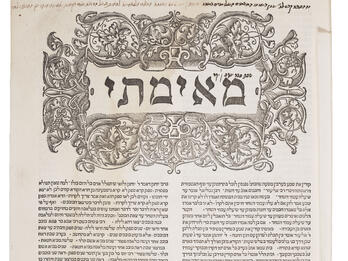Regulations: On Purchasing Copies of the Talmud
The Assembly of Seltz, Adar 1655
502. Since our eyes have seen the great neglect of Torah among schoolchildren, caused by [not] printing of folios of the Gemara [with Rashi’s commentary], because the printer withdraws his hand from printing them, because people avoid buying [full sets of the Talmud] from them, and thereby great damage comes to the printer, we have taken note of this, of how and what to repair in that which has gone wrong. The decision has been made: that every rabbinic court head will impose upon all their communities and settlements the number of Gemaras they will be required to buy. And the communities and settlements will be pressured with all kinds of coercions to enforce it by the commanders, rabbis, heads of rabbinical courts in every community and settlement according to the estimation of their opinion, so that the Torah will be magnified and glorified. [ . . . ]
The Assembly of Chomsk, 1667
Every single community is required to buy folios [of the Talmud with Rashi’s commentary], and the head of every community no fewer than ten folios, and he will distribute them among those students of Torah who cannot afford them, according to the judgment of the rabbi, may the Rock preserve him.
The Assembly, 1679
Since we have surely seen neglect of the Torah, which has been decreasing and diminishing to insufficiency, and only because of lack of folios, which are not around and available when needed, at the beginning of the term [of studies]; for this reason young men and lads are idle from the work of heaven, and their voices do not trill in the houses of study. And thereby to provide support for the Torah and to restore glory and the crown of the Torah to its former state, we have come to reinforce the earlier regulations. And as we were granted authority in the committee in 1676, and as our force was then so is it now, we have come to the help of God in heroism, and we agree and fortify the matter: that in every community the head of the rabbinical court shall meet together with the rabbi to examine and supervise the number of folios needed [for Torah study] for each community and head of the rabbinical court, and also to give some of them to poor Torah scholars for free, also to distribute to the people in surrounding area. And they are required to appoint some available special man for that, who will always buy folios at the fair of Kapuli and the fair of Stalvitsh and make them available at the proper time for the community (and to bring them always before the beginning of the term), and they will be sent to the settlements according to the number that has been estimated for them. And if no householder is available to buy the folios, then the leaders are required to take money from the custodian of the korobka [tax on kosher meat] and purchase folios.
Credits
The Council of the Lands of Lithuania, “Regulations: On Purchasing Copies of the Talmud (Hebrew)” (Manuscripts, The Assembly of Seltz, 1655, The Assembly of Chomsk, 1667, The Assembly, 1679). Republished in: Pinkas ha-medinah o Pinkas vaʻad ha-kehilot ha-rashiyot bi-medinat Lita, ed. Simon Dubnow (Berlin: A̧yanot, 1925), pp. 118, 143, 185.
Published in: The Posen Library of Jewish Culture and Civilization, vol. 5.






